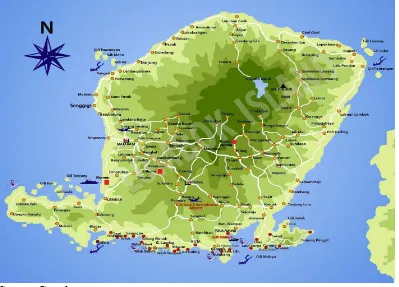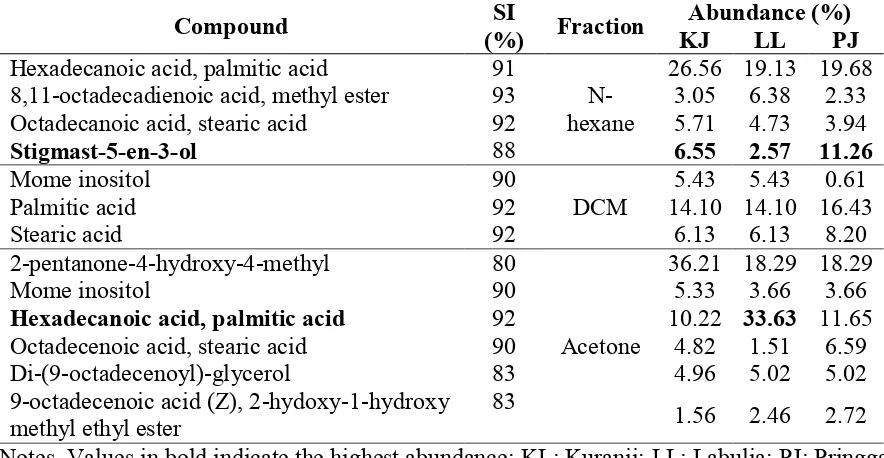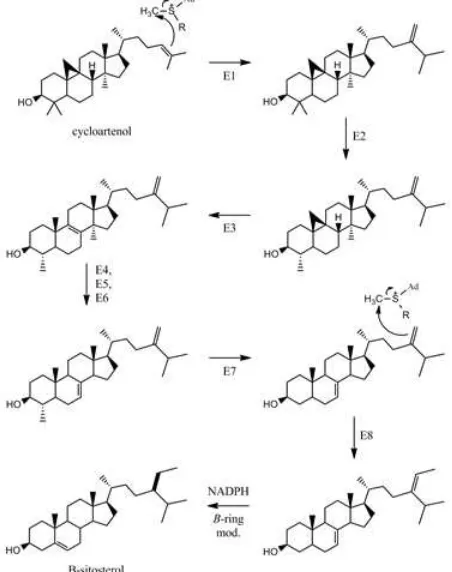The journal homepage www.jpacr.ub.ac.id p-ISSN : 2302 – 4690 | e-ISSN : 2541 – 0733
Metabolite Variation of Peanut Hulls (
Arachis hypogaea L.
)
from
Three Locations of Lombok Island on the Basis of GC-MS
Analysis
Surya Hadi,1 Dina Asnawati,1 Baiq Mariana,1 Hijriati Sholehah,1 Andhina Rizkya Satriani,1 and Seto Priyambodo2
1
Department of Chemistry, Faculty of Mathematics and Natural Sciences, University of Mataram, Jalan Majapahit No. 62 Mataram 83125, Indonesia
2
Faculty of Medicine, University of Mataram, Jalan Majapahit No. 62 Mataram 83125, Indonesia
*
Received 8 March 2017; Accepted 23 August 2017
ABSTRACT
This article is a part of studies to investigate the potential of natural products from Lombok Island for antidiabetic agents. This study was directed to learn the metabolite variations of peanut hulls collected from three different locations in Lombok Island. The hull samples were extracted in methanol, followed by partition process into three fractions using three solvents with varied polarities (dichloromethane, hexane and acetone). The fractions were then separated and identified for their chemical composition by using GC-MS instrument. Metabolite variations of three extracts showed that the antidiabetic compounds stigmast-5-en-3-ol and oleic acid were found in all three locations with different percentages of abundance. Another antidiabetic compound, linoleic acid, was only identified in peanut hulls from the village of Pringga Jurang (PJ). Besides the antidiabetic compounds, there were other major compounds with known biological activities discussed to find other uses of the hulls.
Keywords: Arachis hypogaea L., Metabolite Variation, Antidiabetic, Lombok Island, GC-MS
INTRODUCTION
Peanut (Arachis hypogaea L.) is a tropical crop belonging to the family of Papilonaceae that is cultivated all over Indonesia, including in Lombok Island. Peanuts are mainly utilized as food for its edible seeds, and to a limited extent as livestock’s food and home industry’s fuel for its hulls. Moreover, peanut hulls are also known for its antidiabetic properties traditionally. This is further supported by a study concerning Arachis hypogaea, which indicated that treatment of the extract to normal and alloxan-induced diabetic rats could decrease the fasting blood glucose as well as serum triglyceride, total cholesterol, HDL-cholesterol, and LDL-cholesterol [1]. The compounds with antidiabetic activity were stigmast-5-en-3-ol, linoleic acid, and oleic acid.
cause differences in the metabolites in a species of crop cultivated in different locations. Therefore, this paper discusses the similarities and differences of chemical composition of peanut hulls cultivated in three locations, as well as the potential of peanut hulls utilizations.
EXPERIMENT
Chemicals and instrumentation
The chemicals used were methanol (Merck), n-hexane (Merck), dichloromethane (Merck), and acetone (Merck). Peanut hull samples were collected from three villages, the main cultivation areas for peanuts in Lombok Island: Kuranji (West Lombok), Labulia (Central Lombok) and Pringga Jurang (East Lombok). The samples were prepared by grinding the peanut hulls into fine powder.
Source: Google
Figure 1 Sampling Sites (indicated with )
Instrument used in this study was GC-MS Shimadzu QP2010 ULTRA. The injection temperature was at 290 . Initial column temperature was started at a temperature of 40 for 5 minutes and programmed to increase by 80 min-1, heated until 280 for 2 minutes. Meanwhile, MS was conditioned at a temperature of transfer line of 260 and ion source at 200 . Ion was obtained by electron ionization mode. The RTX-5MS capillary column used had length of 30 m, diameter of 0.25 mm and film thickness of 0.25 µm. Helium was used as the carrier gas with flow rate of 30 mL min-1. Molecular mass range of ions was identified at 35-500 m/z.
Extraction Procedure
was then partitioned by using n-hexane (3 x 30ml) to produce n-hexane fraction and residue. The residue of n-hexane fraction was extracted by dichloromethane (DCM) (3 x 60 mL) to get two fractions of DCM and residue. Lastly, the residue of DCM extract was then extracted with acetone. After evaporation using rotary evaporator, the three fractions were finally analyzed by GC-MS to identify the chemical composition and abundance level of compounds.
RESULT AND DISCUSSION Chemical Contents of Peanut Hulls
The identical compounds identified in n-hexane, DCM, and acetone fractions of peanut hulls from three locations are summarized in Table 1, while the different compounds are presented in Table 2. The confirmation of the chemical structures of the identified compounds is based on the similarity index (SI), which ranges from 80-96%.
Table 1. The identical compounds identified in n-hexane, DCM, and acetone fractions of peanut hulls from three locations of Lombok Island
Compound SI 8,11-octadecadienoic acid, methyl ester 93 3.05 6.38 2.33
Octadecanoic acid, stearic acid 92 5.71 4.73 3.94
Hexadecanoic acid, palmitic acid 92 10.22 33.63 11.65
Octadecenoic acid, stearic acid 90 4.82 1.51 6.59
Di-(9-octadecenoyl)-glycerol 83 4.96 5.02 5.02
9-octadecenoic acid (Z), 2-hydoxy-1-hydroxy methyl ethyl ester
83
1.56 2.46 2.72
Notes. Values in bold indicate the highest abundance; KL: Kuranji; LL: Labulia; PJ: Pringga Jurang
Table 2. The different compounds identified in n-hexane, DCM, and acetone fractions of peanut hulls from three locations of Lombok Island
Compound SI
9-octadecenoic acid, 2-hydroxy 86 √ 0.96
Stigmasta-5, 23-dien-3-ol 91 √ 4.02
9-octadecenoic acid, oleic acid 87 √ 58.65
Hexadecanoic acid,
acid
Hexadecanoic acid, 2-hydroxy 89 √ 1.47
Stigmasta-5,22-dien-3-ol 90 √ 4.72
Hexadecanoic acid 92
DCM
√ 2.36
1,2-Methyl 1-8-hexadecyn-1-ol 80 √ 13.10
Hexadecanoic acid, 2-hydroxy 90 √ 2.36
14-methyl-8-hexadecyn-1-ol 84 √ 13.10
Phenol,4-(1 methylpropyl) 93 √ 2.93
Octadec-9-enoic acid 92 √ 1.16
9-octadecenoic acid, methyl ester 94 √ 0.61
Oleic acid 92 √ 43.26
Cyclopentadecanone 91 √ 33.63
Notes. Values in bold indicate the highest abundance; KL: Kuranji; LL: Labulia; PJ: Pringga Jurang; √: availability of the compound
Antidiabetic Agents in Peanut Hulls
Based on Table 1 and Table 2, generally, there were some similarities and differences in the chemical constituents of peanut hulls from Kuranji (KJ), Labulia (LL), and Pringga Jurang (PJ). Stigmast-5-en-3-ol was identified in n-hexane fraction of peanut hulls from all three locations and the percentages of abundance were 6.55% (KJ), 2.57% (LL), and 11.26% (PJ). Oleic acid was also found in peanut hulls from KL, LL, and PJ with the percentages of abundance 30.29%, 58.65%, and 43.26% respectively. Meanwhile, linoleic acid was only identified in peanut hulls from PJ, specifically in n-hexane fraction, with the percentage of abundance 49.33%. These results indicate that the peanut hulls from PJ are likely to have better antidiabetic agents because they contain the three antidiabetic agents, however, the consistency of the chemicals in the hulls need further study.
result of the current study corroborates that peanut hull has a potential antidiabetic activity. This also supports the recommendation that chemical components of peanut hulls should be added to herbal formulations for the management of diabetes.
Beside the antidiabetic properties, stigmast-5-en-3-ol also possesses other pharmacological activities such as anti-inflammatory, inducing apoptosis, chemoprotective, hypocholesterolemic, angiogenic, genotoxicity, analgesic bioassay, anthelminthic, anti-mutagenic, immunomodulatory, affecting benign prostatic hyperplasia (BPH), prostatic cancer treatment, anti-oxidant, and neuroprotection [9]. As for the antidiabetic fatty acids, oleic acid has an antitumor effect [10] while linoleic acid has antimalarial activity [11].
To understand the biosynthesis of stigmast-5-en-3-ol or -sitosterol, it is essential to know that the compound is a phytosterol (plant sterol). The biosynthesis of phytosterols is regulated during membrane biogenesis. -sitosterol is biologically synthesized from both mevalonate and deoxyxylulose pathways. Using 13C-labeling approach, the mechanism of -sitosterol biosynthesis has been studied and although varies found according to the organism, cycloarteol has been identified as an initial substrate [12].
Figure 2 Biosynthesis of -sitosterol from cycloartenol
Plants synthesize fatty acids using a series of discrete fatty acid synthase II (FAS II) enzymes [13]. There are two soluble FAS II systems in plants, one in plastids (chloroplasts) and another one in mitochondria. The FAS II of the plastids represents the major pathway of plants de novo fatty acid synthesis. The main products from the intraplastidal de novo fatty acid biosynthesis in plants are oleic acid, to a lesser extent palmitic acid, and to a much lesser extent stearic acid. Accordingly, oleic acid is further desaturated to (9Z,12Z)-octadeca-9,12-dienoic (linoleic) acid [14].
LL, the main fatty acid was oleic acid (30.29% KJ, 58.65% LL) followed by palmitic acid (10.22% KJ, 33.63% LL). Meanwhile in peanut hulls from PJ, the main fatty acid was linoleic acid (49.33%) which could be resulted from the desaturation of linoleic acid. This difference may be due to the different mechanism of the biosynthesis.
Other Major Compounds Identified in Peanut Hulls
There were three other major compounds found in peanut hulls namely 9-octadecenal (47.77%, KJ), palmic acid (33.63%, LL), and cyclopentadecanone (33.63%, PJ). This proves that the chemical compositions of peanut hulls from three different locations are different which may be caused by climate and the characteristics of the soil.
Two of these major compounds are already known for their biological activity. Found in the n-hexane fraction of peanut hulls from KJ, 9-octadecenal has the ability to control human pathogens, pests, termites, and maggots [15]. Another compound, palmitic acid, has the potential as antibacterial and antifungal agent [16], as well as anticancer agent [17].
CONCLUSION
The result of GC-MS analysis showed that there were two antidiabetic agents with different percentages of abundance identified in A. hypogaea hulls from KJ, LL, and PJ namely stigmast-5-en-3-ol and oleic acid, while a high abundance of antidiabetic agent, Linoleic acid (9,12-octadecedienoic acid), was only found in PJ. Other major compounds with known biological activities were 9-octadecenal found in KJ, hexadecanoic acid and palmitic acid found in LL. Different chemical constituent from this study indicated that different planting location might significantly impact the metabolites in A. hypogaea hulls and those compounds could be explored for different purposes.
ACKNOWLEDGMENT
We would like to thank Mr. Ruru Honiar, the technician of Laboratory of Analytical Chemistry Faculty of Mathematics and Natural Sciences University of Mataram, for his assistance in GC-MS analysis.
REFERENCES
[1] Bilbis, L. S., Shehu, R. A., & Abubakar M. G., Phytomedicine, 2002, 9(6), 553-555. [2] Kumar, S., Kumar, V., & Prakash, O., BioMed Res. Int., 2013, 1-7. Hakim, M. N., Molecules, 2012, 17(8), 9631-9640.
[6] Houseknecht, K. L., Vanden, H. J. P., Moya-Camarena, S. Y., Portocarrero, C. P., Peck, L. W., Nickel, K. P., et al., Biochem Biophys Res Commun, 1998, 244, 678-682.
[7] Vassiliou, E. K., Gonzalez, A., Garcia, C., Tadros, J. H., Chakraborty, G., & Toney, J. H., Lipids Health Dis, 2009, 8(25).
[8] Rosa, Jagoda & Rosa Josip, Diabetol Croat, 2004, 33(1), 17-21.
[9] Saeidnia, S., Manayi, A., Gohari, A. R., & Abdollahi, M., European J Med Plants, 2014, 4(5), 590-609.
[11] Melariri, P., Campbell, W., Etusim, P., & Smith, P., Adv Stud Biol, 2012, 4(3), 333-349. [12] Dewick, P. M., Medicinal Natural Products: A Biosynthetic Approach, 2009, John
Wiley & Sons Ltd, New Jersey.
[13] Kunst, L., & Samuels, A. L., Prog Lipid Res, 2003, 42, 51-80. [14] Velíšek, J., & Cejpek, K., Czech J Food Sci, 2006, 24(5), 193-216.
[15] Manilal, A., Sujith, S., Sabarathnam, B., Kiran, G. S., Selvin, J., Shakir, C., et al., Acta Bot Croat, 2011, 70(1), 81-90.
[16] McGaw, L. J., Jager, A. K., & Van Staden, J., Fitoterapia, 2002, 73(5), 431-433.


